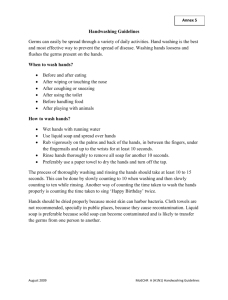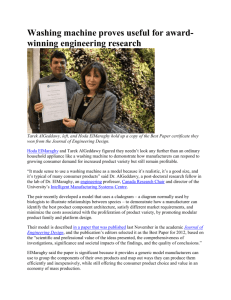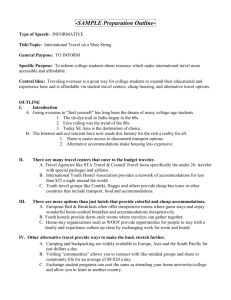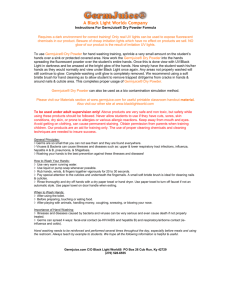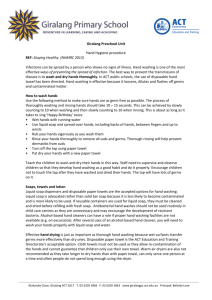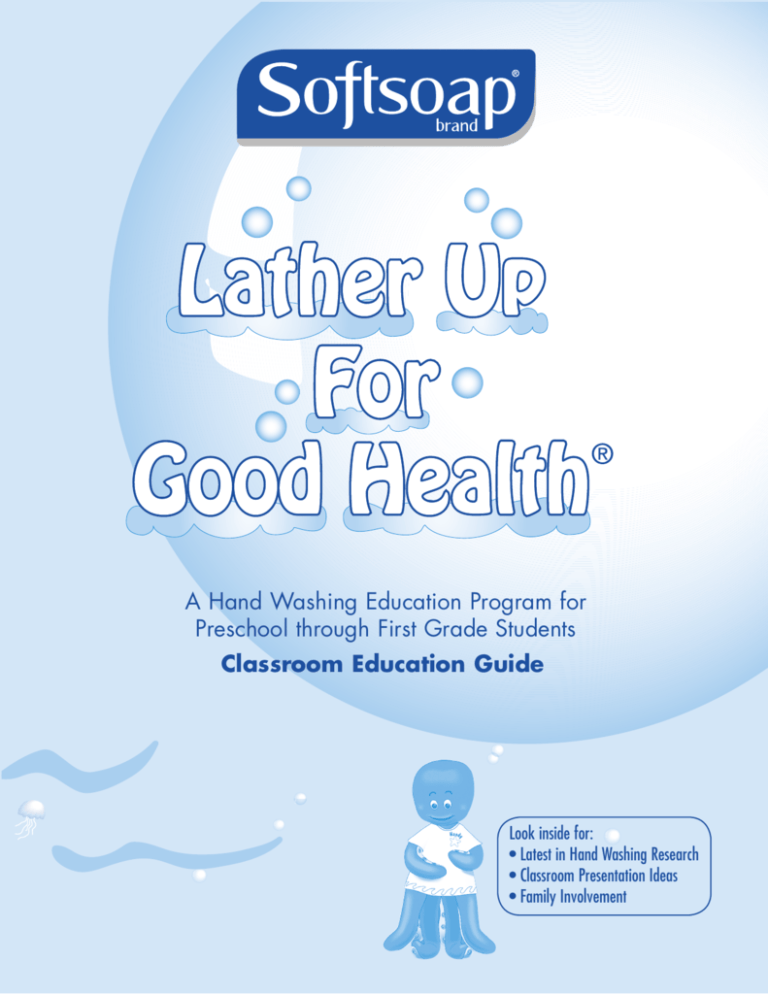
A Hand Washing Education Program for
Preschool through First Grade Students
Classroom Education Guide
Look inside for:
• Latest in Hand Washing Research
• Classroom Presentation Ideas
• Family Involvement
Dear Educator,
As a teacher or school nurse, you are already aware of the benefits of hand washing. But you are faced
with the challenge of getting your school students excited about it, too. The Softsoap® Lather Up for Good
Health® program – featuring Handy™ the Hand Washing Octopus – serves as a game plan for engaging
kids and teaching them the importance of hand washing.
Staying healthy is important all year long – but cold and flu season is a particularly challenging time for
schools. This program is designed to give you additional ammunition in your fight against infectious disease
with new data and some “hands-on” education tools to help you get the word out to children and their
families!
Hand Washing Education Program
This Softsoap® Lather Up for Good Health® hand washing education program for Preschool, Kindergarten
and First Grade students includes this Classroom Education Guide as your roadmap to the program. See page
3 for a look at the other kit components.
Hand Washing Research
Page 7 features a recap of studies that discuss the effectiveness of a hand washing intervention program at
the preschool level. It gives you the documentation you need to demonstrate that hand washing really does
work!
Hand Washing Web Connection
www.latherupforgoodhealth.com is an interactive website offering a host of educator information and
kid-friendly activities. We’ve highlighted those within this guide via “Web Connections.”
Now, it’s time to get started. Good luck!
Sincerely,
Dr. Marsha E. Butler
Vice President
Global Professional Relations
Colgate-Palmolive Company
© 2005, 2010 Colgate-Palmolive Company. All Rights Reserved.
2
Your Components At-A-Glance
The materials are straightforward and simple, with activities that involve children in developing a “clean hands” school
environment. The components make it easy to lead them through the WHYs, WHENs, and HOWs of hand washing.
Classroom Education Guide
DVD: Handy and his Helpers
This eight-page guide offers classroom
activities and presentation ideas.
• Hand washing research
• Family involvement
An undersea exploration of why, when,
and how to wash hands. Features
Handy™ the Hand Washing Octopus
and his four engaging helpers.
• Running time: 11 minutes
• Song lyrics are printed on page 6
of this guide
Reproducible Family Take-Home
Hand Washing Poster
This two-sided handout encourages
hand washing at home.
• Available for download from the DVD
• At-home hand washing instructions
• A week-long hand washing log
A two-sided, full-color poster
for twice the learning!
• Side 1: When to Wash
• Side 2: How to Wash
Family Hand Washing Pledge
Reproducible Family Hand Washing Pledge
Parent/Caregiver: Read the first part aloud with your child.
Read the last part to your child, then sign your names.
Adult and Child:
We’ll wash our hands all through the day
Before we eat and after we play
After touching pets, or when we cough or sneeze
And after using the bathroom. Soap and water, please!
Signed:
Adult Alone:
I’ll show you how to keep hands clean
Washing front and back and in between.
At home, I’ll keep soap at each sink for you
So you can scrub with bubbles – and I will, too!
Grown-up _________________________________________
Date ____________
Child _______________________________________________
Date ____________
WEB CONNECTION:
Parents/caregivers: For more information on hand washing and to find fun family
involvement activities, check out www.latherupforgoodhealth.com.
This interactive pledge can be found on the
back cover of the Classroom Education Guide.
• Reinforces family participation
© 2005, 2010 Colgate-Palmolive Company. All Rights Reserved.
Getting Started
By sharing the Lather Up for Good Health® education program with children, you’ll get them excited about washing
their hands and help instill critical, long-term healthy habits. The components are flexible and can be used in the
classroom, in the nurse’s office, or a combination of both. Plan your lesson according to how much time you have
available.
Presentation Checklist
School Nurse: Ideas for Your
Classroom Visit
In advance
Team teach with the teacher
•Reserve TV/DVD player if the classroom doesn’t have
one.
•If possible, laminate the poster to protect it,
especially if you plan to take it from class to class.
•Print and photocopy the Reproducible Family Takehome from the DVD and the Hand Washing Pledge
on the back cover – one for each child.
•Talk to the teachers in Preschool, Kindergarten and First
Grade classrooms to plan your visit.
• Let the teachers know that you’ll be bringing take-home
materials with you.
• Encourage teachers to team teach the program with
you and continue to conduct follow-up activities and
reminders afterwards.
Nurse’s Timing Tip:
Try to arrange visiting the classroom right before lunch
or snack time. It makes a great entrée to the
topic of hand washing!
3
Using the Components
DVD
POSTER
Explore Prior Knowledge
Announce that you are there to talk about
your good friend Handy™ the Octopus.
He’s a very smart and healthy guy!
In fact, octopuses are the smartest of all
invertebrates! Ask the children what they
know about octopuses. Have they ever
heard of a blue octopus before? Chat with them about
how Handy™ has eight “hands” and lives in the ocean.
He uses all eight to eat with.
Tell the children that today, they will watch a movie
about Handy™, an expert on washing hands – after all,
he has eight of them! Ask them: how would you like to
have eight hands to wash? What would that be like?
Let the children know Handy™ also has four friends:
Dexter, Digit, Pointy, and Pinkie. The only thing is, they
had a lot to learn about hand washing. What would it
be like if you had never learned about hand washing
before?
Introduce the DVD by asking children:
•How many of you washed your hands today?
•Why did you wash your hands? (to wash away any
germs that might be on your hands)
•What might happen if you didn’t wash those germs
away? (you might get sick)
•What did you use to wash your hands? (soap + water).
Show the DVD
• Running time: 11 minutes
•Storyline: Handy™ the Octopus and his four “helping
hands” – Dexter, Digit, Pointy, and Pinkie – teach
kids ­the benefits of washing their hands through
engaging songs and “hands-on” demonstrations.
• Original Music: The lessons are presented via clever
hand washing songs. The three songs emphasize the
three key learnings: WHY to wash, WHEN to wash,
and HOW to wash. Lyrics are printed on page 6.
Follow up the DVD viewing by
using the poster to review the
“when” and “how” of washing
hands.
Side 1: When to Wash
• Show the children the “When to Wash” side of the poster.
• Invite the children to describe what they see
happening in the pictures. What are the Helpers showing
us are the important times to wash our hands?
•Be sure to watch for the message from the “sneezing”
crab!
Before:
• Eating or touching food
After:
•Using the bathroom
•Sneezing, coughing, or blowing your nose
•Coming in from outside
•Playing with pets
Side 2: How to Wash
•Flip the poster over to the
“How to Wash” side.
•Ask if someone would like to
come up to the poster and
show and/or tell the rest of
the class how Handy™ says to wash our hands. Repeat
the words on the poster and have children repeat them:
• Soap + Water • Bubbles • Rub • Rinse • Dry
•Ask: What happens when we wash our hands?
(the germs go down the drain).
•Follow-up: Let each child come up and describe the steps
and then go wash his/her hands if a sink is accessible.
This step is also an excellent follow-up activity for the
teacher after the presentation. If a sink isn’t available,
have children act out the motions of hand washing.
4
Using the Components
REPRODUCIBLE FAMILY TAKE-HOME
The two-sided, black and white take-home is
available for download from the DVD. It is
designed to be printed and then reproduced for
each child to take home and share with their
family. Have the kids to bring their completed hand
washing logs back to school for a class tally!
Side 1 – Hand Washing: Check it Out!
•Show the children the “Hand
Washing: Check it Out!” chart.
Tell them that Handy™ wants
them to check off every time
they wash their hands for one
week (7 days). Using the directions on the chart, explain to the children how
they mark their chart.
•Have the children put their “Hand Washing Logs”
in their cubbies to take home.
•Tell them that after they have washed their hands
for a week, they should bring the charts back to
school. The class will tally results as a group and
talk about how successful their hand washing
efforts have been.
Side 2 – Hand Washing at Home
Let the children know that this side
is for their parents and families.
Family Pledge
Using the Family Hand Washing Pledge
Reproducible (Back Cover)
The pledge includes a “child and parent” pledge
and a “parent only” pledge. You can use the pledge
in several ways.
•The children can decorate it or color it in and then
take it home to share with families; or, you can
distribute it directly to parents/caregivers.
•You and/or the teacher can recite the “together”
part of the pledge along with the children in the
classroom.
•Families can learn the pledge and recite it
together as a family involvement activity.
SCHOOL NURSES: WORKING WITH FAMILIES
School Registration Day, Health Fairs, and PTO Meetings
Hand washing also makes an excellent topic for School Registration
Day, Health Fairs, and PTO Meetings. As children transition to the
public school environment, good hand washing habits become
even more critical. You can even use the materials in the kit to get
parents involved! Consider these ideas for alerting families about
the importance of hand washing at home.
For Health Fairs and School Registration Day
• Play the DVD at your display table. If possible, borrow a DVD
player with looping capabilities.
• Provide copies of reproducible take-homes for families. Make
sure that each family gets a Family Hand Washing Pledge!
• Post the poster adjacent to your display table. Invite visiting
children to describe what they see on the poster.
• If possible, place your display table near a sink to encourage
on-site hand washing!
For PTO Meetings
• Let parents know about your new school effort to stay healthy
by washing hands. Explain that you are promoting hand
washing compliance at school – but that’s only half the battle!
You’re asking for them to promote hand washing by modeling
it at home, too.
• Share current statistics from the research highlights on page 7
with parents. For example, engage them with the fact that CDC
statistics show that infectious diseases account for more than
164 million lost school days each year in grades K–12!
• Consider playing the DVD for the audience. If possible, plan
to have some of the children attend the meeting to sing/act out
the songs during the show.
• Distribute copies of the Family Pledge to the group.
WEB CONNECTION:
Parents can find facts and fun at:
www.latherupforgoodhealth.com.
The site also contains educational activities
for students in grades pre-K through 3.
Spread the good, clean news!
5
Songs
The Why To Wash Song
If you want to be healthy
If you want to be smart
If you want to feel clean,
Here’s a great place to start!
It’s as easy as 1-2-3,
If you just listen to me.
You
You
You
You
gotta
gotta
gotta
gotta
wash,
wash,
wash,
wash,
wash,
wash,
wash,
wash,
wash your hands,
wash your hands,
wash your hands,
wash, wash, wash your hands!
I want to be healthy
I want to be smart
I want to feel clean
So get ready to start!
It’s as easy as A-B-C,
If you just listen to me.
The When to Wash Song
When you (COUGH)
When you (SNEEZE)
When you (WOOF)
When you (MEOW)
When you (DOOR)
When you (FLUSH)
I know you understand:
After all these things, you got to wash your hands.
Wash your hands, wash your hands
You’ve got to, got to wash your hands,
Wash your hands, wash your hands
After all these things you’ve got to wash
your hands.
How to Wash: The Handy Hand Washing Song
You gotta wash, wash, wash your hands,
You gotta wash, wash, wash your hands,
You gotta wash, wash, wash your hands,
You gotta splish splosh, swish swash, wash wash, wash
your hands.
Well, you gotta wet, wet, wet your hands
You gotta soap, soap, soap your hands
You gotta rub, rub, scrub your hands
You gotta rinse, rinse, rinse your hands.
Then you got to dry your hands,
That’s the way we wash our hands,
That’s the way we wash . . .
The way we wash our hands!
Follow-up Activity: Germs, Germs Go Away!
Getting Ready
Have a “beanbag-like” object, preferably one in a “yucky” color, and pretend that it’s a germ.
Playing Germ, Germ Go Away!
1. Have the children sit in a big circle. Have one child volunteer to be “It” and stand in the center of the circle.
2. Give one child in the circle the “germ,” and have the children pass it around the circle while they chant
“Germ, germ go away!”
3. When the child who is “It” says, “Handy says!,” the child that is holding the “germ” beanbag must respond,
”Wash your hands!” before the child who is “It” taps them. If not, the child holding the
beanbag becomes “It,” and takes his/her place in the center of the circle.
WEB CONNECTION:
For more classroom activity and follow-up ideas,
visit www.latherupforgoodhealth.com!
6
Highlights from Research Study:
Successful Hand Washing Education in Schools
Hand washing is a basic, everyday process — but it is
also a skill and behavior that must be learned as a child.
As with all skills, the earlier that a child learns and
incorporates the action into a routine, the more likely it is
to become a lifelong habit.
Hand washing is a key step in helping to keep us
healthy. According to the U.S. Centers for Disease
Control and Prevention (CDC), “The most important thing
that you can do to keep from getting sick is to wash your
hands.”1 Unfortunately, improper or infrequent hand
washing continues to be a major factor in the spread
of disease. CDC statistics show that infectious diseases
account for more than 164 million lost school days each
year in grades K–12.2 “Nearly 22 million school days
are lost to the common cold alone,” and research shows
that many of those missed days could be prevented by
proper hand washing.3
Hand Washing Intervention
To help kids build a healthy habit, Colgate-Palmolive set
out to help teachers make hand washing in the classroom
an easy, automatic process, while making hand washing
fun and desirable for children. The result was the original
Softsoap® Lather Up for Good Health® program, with
five teacher-directed classroom activities, a classroom
game, and hand washing charts.
A pilot study, conducted in 1999, found that educational
programming, such as the Softsoap® Lather Up for Good
Health® program, can improve hand washing habits
and knowledge.
Following up on the findings of that study, ColgatePalmolive conducted research to test the efficacy of
the program as a tool to help improve hand washing
behavior both at home and at school. The
objective of the 2002 study was to demonstrate a
change in hand washing knowledge and practice by
preschool children after they participated in the program.
Colgate-Palmolive tested its key messages of why, when
and how to wash one’s hands among 133 preschool
children in four Head Start locations across the United
States (Massachusetts, California, Minnesota, Georgia).
The University of Medicine & Dentistry of New Jersey/
School of Public Health participated in the study.
Results show improvement in all three knowledge areas:
• Why: Before participating in the Lather Up for Good
Health® program, 46% of preschoolers surveyed
reported knowing what germs can do, and 53%
were unsure of what to do to get rid of germs. After
participating in the program, 93% of the children
understood what germs can do and 86% understood
that we can avoid germs and stay healthy by
washing hands.
• When: When asked, “When do you think you should
wash your hands?”, 26% of children didn’t know the
answer before the program. After participating, only
6% still did not know when hands should be washed.
Additionally, there was a statistically significant increase
in knowledge of important times to wash hands: before
eating, after using the bathroom, after playing outside,
after playing with pets, and after sneezing, coughing, or
blowing one’s nose.
• How: Teaching the hand washing program resulted in
an increase in hand washing time by an average of
12 seconds. Statistically significant increases were also
observed in making lather, washing between fingers,
and washing under the nails.
The importance of hand washing education is evidenced
by the fact that 81% of the preschool children in this
study claimed to wash their hands by themselves, without
adult assistance. Yet, their knowledge indicates a gap in
knowing when and how to wash. If they receive
assistance in hand washing, it comes from their
mothers/caregivers. Teachers and school nurses can
be instrumental in promoting good health through
proper hand washing, and helping to close the gap in
knowledge and practice.
WEB CONNECTION:
Visit www.latherupforgoodhealth.com
for more on this study.
1 Centers for Disease Control and Prevention: http://www.cdc.gov/Features/Handwashing, 4/5/2000, accessed 2/1/2010
2 Adams PF, Marano MA. Current estimates from the National Health Interview Survey, 1994. National Center for Health Statistics. Vital Health Stat 10(193). 1995.
3 Centers for Disease Control and Prevention­: http://www.cdc.gov/germstopper/home_work_school.htm, 2/2/2004, accessed 2/1/2010
7
Adult and Child:
Adult Alone:
Date ____________
Child _______________________________________________
Parents/caregivers: For more information on hand washing and to find fun family
involvement activities, check out www.latherupforgoodhealth.com.
WEB CONNECTION:
Date ____________
JMH Education, New York, NY
I’ll show you how to keep hands clean
Washing front and back and in between.
At home, I’ll keep soap at each sink for you
So you can scrub with bubbles – and I will, too!
Grown-up _________________________________________
© 2005, 2010 Colgate-Palmolive Company. All Rights Reserved.
Signed:
We’ll wash our hands all through the day
Before we eat and after we play
After touching pets, or when we cough or sneeze
And after using the bathroom. Soap and water, please!
Parent/Caregiver: Read the first part aloud with your child.
Read the last part to your child, then sign your names.
Family Hand Washing Pledge

